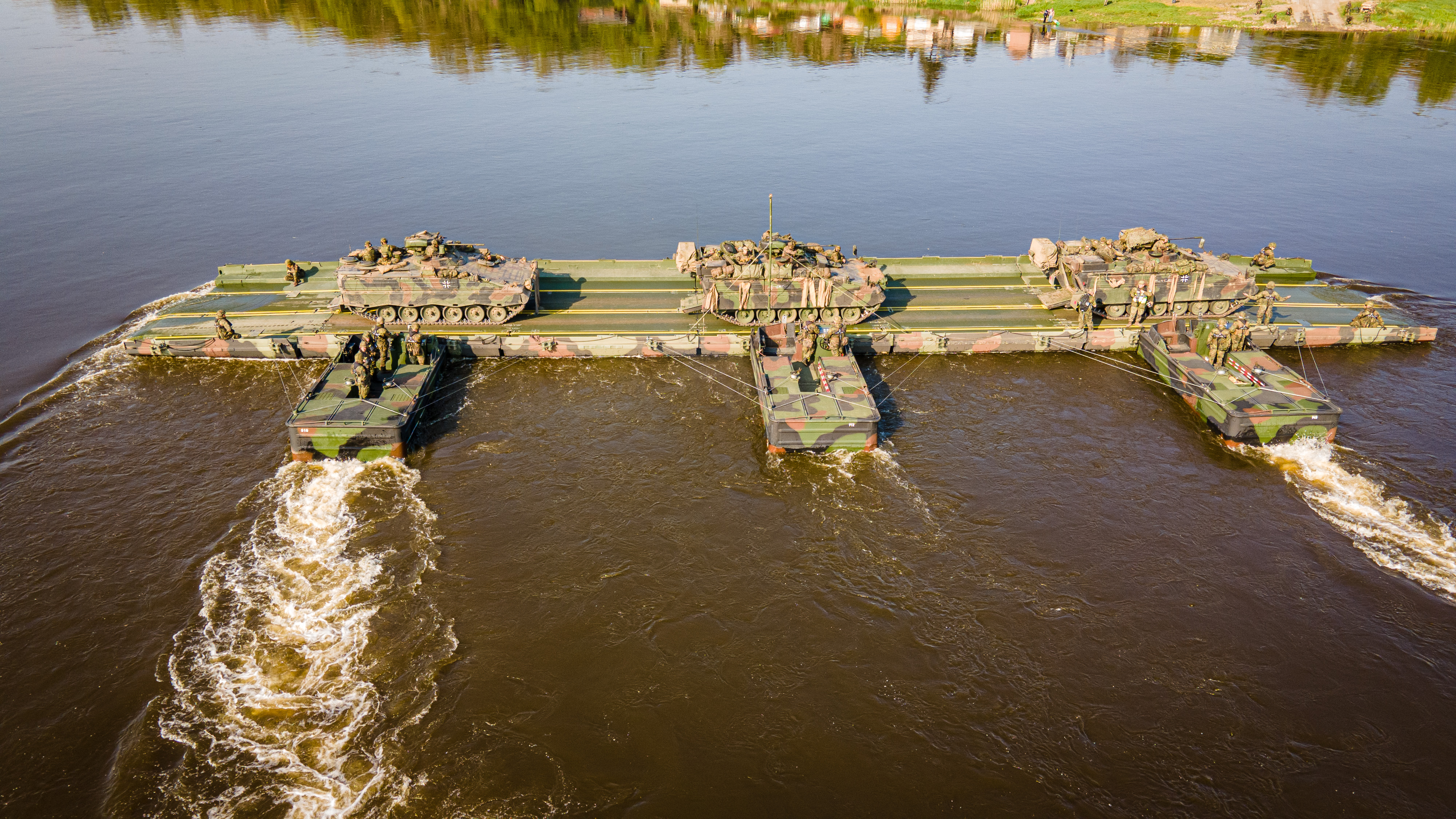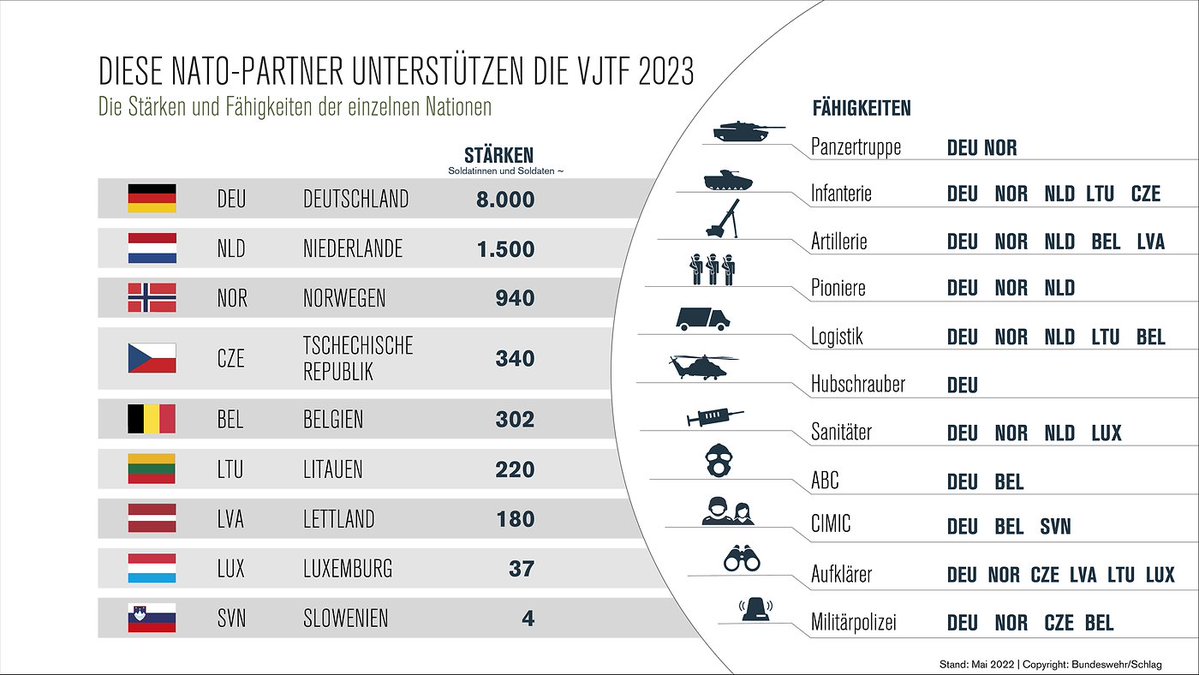Minden ami Bundeswehr (Németország)
- Téma indítója Luthero
- Indítva
You are using an out of date browser. It may not display this or other websites correctly.
You should upgrade or use an alternative browser.
You should upgrade or use an alternative browser.
Németország április 30-án felállította első Heimatschutzregement-jét (honvédelmi ezred) – jelentette be a Bundeswehr támogató parancsnoksága. A Bundeswehr a honlapján közölte, hogy a Landesregiment Bayern (bajor állami ezred) nevet Heimatschutzregiment 1-re keresztelték, és hét századát az utóbbi parancsnoksága alá helyezték, egy parancsnoksággal és logisztikai egységgel, speciális gyalogsági, felderítő és mérnöki képességekkel.
Az ezred 700 tartalékosával az első az öt közül, és a Bundeswehr szerint az ország területi tartalékának új szervezetét képviseli. Christine Lambrecht német védelmi miniszter az ezred felállási ünnepségén azt mondta: „A nemzeti területvédelem és a honvédelem a szövetség védelmének kulcselemei. Egy erős tartalék garantálja, hogy a Bundeswehr ott van... amikor szükség van rá”, lehorgonyozva magát a társadalomban. „A honvédelmi ezredekkel és századaikkal erősítjük hazánk válságokkal és katasztrófákkal szembeni ellenálló képességét”.
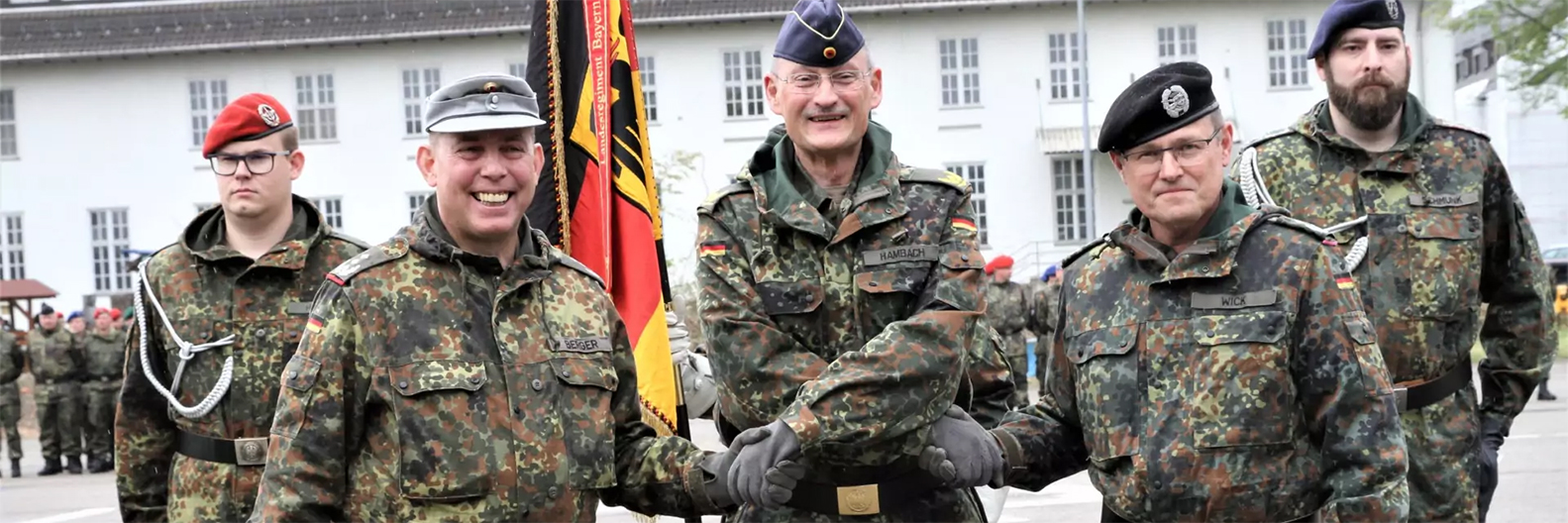
 www.reservistenverband.de
www.reservistenverband.de
Az ezred 700 tartalékosával az első az öt közül, és a Bundeswehr szerint az ország területi tartalékának új szervezetét képviseli. Christine Lambrecht német védelmi miniszter az ezred felállási ünnepségén azt mondta: „A nemzeti területvédelem és a honvédelem a szövetség védelmének kulcselemei. Egy erős tartalék garantálja, hogy a Bundeswehr ott van... amikor szükség van rá”, lehorgonyozva magát a társadalomban. „A honvédelmi ezredekkel és századaikkal erősítjük hazánk válságokkal és katasztrófákkal szembeni ellenálló képességét”.

Heimatschutzregiment 1 in Bayern in Dienst gestellt - Reservistenverband
Das Pilotprojekt ist abgeschlossen, die Neuordnung der Territorialen Reserve läuft. Bei einem feierlichen Appell am vergangenen Samstag hat der Stellvertreter des Inspekteurs der Streitkräftebasis, Generalleutnant Jürgen Weigt, das Landesregiment Bayern in Heimatschutzregiment 1 umbenannt. Im...
 www.reservistenverband.de
www.reservistenverband.de
K
kamm
Guest
előfizetős összegeznéd ?
Germany’s Military Industry Gears Up to Restock Its Own Forces
The country’s chancellor has pledged about $100 billion to rebuild its army, but that increase in spending may not be enough to reverse years of neglect, experts say.

The Krauss-Maffei Wegmann factory in Munich was motivated to modernize its military when Russia invaded Ukraine. Felix Schmitt for The New York Times
Melissa Eddy and Jack Ewing
Melissa Eddy, who reported from Munich for this article, is the German business correspondent, a role that U.S.-based Jack Ewing held for 12 years.
May 5, 2022
Shortages of body armor. Radios so antiquated they are the butt of jokes from other NATO soldiers. A dysfunctional procurement system that takes years just to acquire shoulder patches.
After decades of budget cuts, the German military is woefully short of basic supplies, whether they’re bullets or backpacks. But galvanized by Russia’s invasion of Ukraine, Chancellor Olaf Scholz has pledged to spend 100 billion euros, or $105 billion, to modernize the force, nearly tripling military spending from the previous year.
The quantum leap in arms expenditures “is long overdue,” said Wolfgang Richter, a retired colonel in the German Army who is now with the German Institute for International and Security Affairs in Berlin. “For a long time we believed that economic strength was enough. But the events of the past few weeks have shown that we also need a strong military.”
The military’s wish list includes new ships, new helicopters, and more tanks and other armored vehicles. But it may take years to deploy the money and make the German Army, with 184,000 soldiers, an effective deterrent to Russia, experts say.
It’s not for lack of a German arms industry, including major manufacturers like Rheinmetall, which makes armored vehicles, and Rohde & Schwarz, which provides military communications equipment. Volkswagen’s Traton unit has a joint venture with Rheinmetall to produce military vehicles.
And there is Krauss-Maffei Wegmann, which has kept its factory in Munich busy by selling Leopard 2 main battle tanks to numerous foreign armies. In fact, German defense contractors export almost as many arms as they sell to their own country’s military.
In halls the size of airplane hangars, mechanics and technicians at Krauss-Maffei Wegmann currently work just one flexible shift, updating and repairing tanks and armored vehicles used by the armed forces of 19 countries.
On a recent weekday, amid hulking vehicles parked in bays that line the repair halls, an employee drove a new Leopard into position, then used a crane to remove a turret that needed adjusting. In addition to the tanks, several newly made Boxer armored personnel carriers were being prepared for Lithuania, one for medical emergencies and another to carry troops.

Germany's capacity to aid Ukraine is limited because its own military does not have all the modern equipment it needs. Felix Schmitt for The New York Times
Ralf Ketzel, a former artillery officer who is Krauss-Maffei Wegmann’s chief executive, said it would take no more than two years to begin delivering the several hundred Leopard 2s and Pumas — a kind of combination tank and armored personnel carrier — that Germany’s three combat divisions needed.
“The situation is not as bleak as it is sometimes portrayed,” Mr. Ketzel said.
Germany’s rearmament amounts to a kind of economic stimulus program on a wider scale, because German contractors buy supplies from around the continent, and the military buys directly from European and American companies. The German Defense Ministry has said it wants to order F-35 fighter jets made by Lockheed Martin to replace aging Tornado fighters.
Carl Jonasson, the chief executive of Snigel Design, a Swedish maker of backpacks, camouflage cloaks and other combat apparel, was surprised to receive an order from Germany recently.
“It’s just mind-blowing numbers, at least for European standards,” Mr. Jonasson said of Germany’s €100 billion war chest.
As impressive as that sum sounds, it will not be enough for Germany to make up for years of inadequate spending, according to the Ifo Institute, an economics research organization in Munich. To meet its North Atlantic Treaty Organization quota in the long term, Germany must commit another €25 billion a year, Ifo economists said in a recent report.
Mr. Scholz has promised that defense spending in coming years would amount to more than 2 percent of national output, the minimum agreed upon by NATO members. His declaration was hailed as a “Zeitenwende,” a historic turning point.
In another indication of the shift in the political mood, the German Parliament agreed in April to provide lethal weapons and defense systems to Ukraine, overcoming Germans’ post-World War II reluctance to getting involved in armed conflicts. German manufacturers have provided the government with lists of weapons, armored vehicles and defense systems they could supply quickly to the Ukrainian Army.
But Germany’s capacity to aid Ukraine is limited because its own military does not have all the modern equipment it needs. Much of what Germany is offering Ukraine is older equipment that has been in storage and needs to be refurbished and modernized.
Moreover, many defense companies, accustomed to shrinking expenditures, have cut manufacturing capacity and will need several years to ramp up production. Suppliers may not be able to provide necessary parts in time, or may have gone out of business.

Krauss-Maffei Wegmann has kept busy making munitions for foreign armies. Felix Schmitt for The New York Times

A mechanic worked on an armored fighting vehicle. Felix Schmitt for The New York Times
And often Germany’s procurement system is agonizingly slow. Delivery of a new assault rifle manufactured by Heckler & Koch, which also supplies the U.S. Marine Corps, is seven years behind schedule because of a German law that allows the losing bidder for a defense contract to challenge the decision in court.
Not long after Mr. Scholz announced the increase in spending, the Defense Ministry summoned executives of major contractors to Berlin. One of the messages: Stop suing one another and work as a team, according to three people with knowledge of the meeting. The Defense Ministry declined to comment.
Germany has long had an ambivalent relationship with its military because of its association with Nazi atrocities in World War II. During the Cold War, Germany was on the front lines. West Germany stood with NATO while East Germany was allied with the Soviet Union. Both had formidable armies.
At the same time, a strong pacifist strain influenced West German politics. After reunification and the collapse of the Soviet Union, there was little support for a large military. The German Army reoriented itself for foreign deployments in Kosovo or Afghanistan, rather than national defense.
“We had hoped that after the Cold War and the fall of the Berlin Wall, there would be lasting peace in Europe and that we could establish a European order of peace together with Russia,” said Eva Högl, a lawmaker for Mr. Scholz’s party, the Social Democrats, who serves as armed forces commissioner in Parliament. “This belief has been brutally shattered, and consequently there is now a new appreciation for the necessity of the military.”
A March report to Parliament by Ms. Högl detailed the armed forces’ shortcomings, including shortages of basic equipment like body armor and winter jackets. The system for buying supplies is so dysfunctional that an intelligence unit was waiting to receive uniform insignia it ordered in 2020.
During maneuvers in Lithuania, according to the report, German soldiers were laughed at by soldiers from other NATO armies because they didn’t know how to use the latest communications equipment. The radios they had trained with in Germany were obsolete.
K
kamm
Guest
In 1989, when the Berlin Wall fell, West Germany had 12 divisions and nearly half a million soldiers facing the collective armies of the Communist Warsaw Pact, which was controlled by Moscow. Now it is struggling to meet its obligation to contribute three combat-ready divisions to NATO. It has about 300 tanks in operating condition, compared with around 4,000 at the end of the Cold War.
Many Social Democrats who now lead the governing coalition have cultivated economic and political ties with Russia, following the lead of Gerhard Schröder, the former chancellor. They promoted projects that made Germany dependent on Russian gas on the mistaken premise that economic ties would restrain Russia’s president, Vladimir V. Putin. The party’s past affinity for Russia makes for an awkward transition to a more muscular military stance.
Defense contractors say they are still waiting to hear how most of the €100 billion will be allocated.
“While we are certainly in regular and constant contacts with our German customer side, we are not really in the position yet to specify possible impacts of proposed spending on our business,” David Voskuhl, vice president of public relations for Diehl Defence, an ammunition supplier, said in an email.

A Leopard 2 tank turret at the Krauss-Maffei Wegmann factory.
Felix Schmitt for The New York Times
But before Germany can consider costly new weapons systems, it must address basic needs. Probably €20 billion will be needed just to refill ammunition depots, according to some estimates. Ships have so few rounds for their cannons that they would run out after a few salvos, experts say. Another €20 billion or more will be needed to buy modern communications equipment. More than €2 billion will be used for the everyday needs of foot soldiers, like backpacks.
Contractors, eager to take advantage of Germany’s newfound military commitments, are adopting a can-do attitude.
Days after Russia invaded Ukraine in late February, Rheinmetall sent the government a list of weapons, defense systems and vehicles it said it could quickly supply to the army. Krauss-Maffei Wegmann told Berlin that it could deliver several dozen Gepard mobile antiaircraft systems that the German Army decommissioned more than a decade ago.
Defense Minister Christine Lambrecht said recently that up to 50 of the vehicles, capable of shooting down Russian jets, could be sent to Ukraine. Ukrainian crews would get six to eight weeks of training in Germany.
But first the Gepards would need servicing and upgrading after years of standing parked on Krauss-Maffei Wegmann’s sprawling grounds. The company is waiting for a confirmed order from the government before work begins, said Christian Budde, a spokesman for the company.
There is still a risk that plans to increase spending could be delayed or undone by political wrangling. But support for a strong military has probably never been higher since the end of the Cold War.
“Through the war in Ukraine,” said Ms. Högl, the armed services commissioner, “many Germans have realized why we have the military and why it is urgently needed, namely to defend peace, democracy and security.”
Melissa Eddy reported from Munich, and Jack Ewing from New York. Christopher F. Schuetze contributed reporting from Berlin.
Many Social Democrats who now lead the governing coalition have cultivated economic and political ties with Russia, following the lead of Gerhard Schröder, the former chancellor. They promoted projects that made Germany dependent on Russian gas on the mistaken premise that economic ties would restrain Russia’s president, Vladimir V. Putin. The party’s past affinity for Russia makes for an awkward transition to a more muscular military stance.
Defense contractors say they are still waiting to hear how most of the €100 billion will be allocated.
“While we are certainly in regular and constant contacts with our German customer side, we are not really in the position yet to specify possible impacts of proposed spending on our business,” David Voskuhl, vice president of public relations for Diehl Defence, an ammunition supplier, said in an email.

A Leopard 2 tank turret at the Krauss-Maffei Wegmann factory.
Felix Schmitt for The New York Times
But before Germany can consider costly new weapons systems, it must address basic needs. Probably €20 billion will be needed just to refill ammunition depots, according to some estimates. Ships have so few rounds for their cannons that they would run out after a few salvos, experts say. Another €20 billion or more will be needed to buy modern communications equipment. More than €2 billion will be used for the everyday needs of foot soldiers, like backpacks.
Contractors, eager to take advantage of Germany’s newfound military commitments, are adopting a can-do attitude.
Days after Russia invaded Ukraine in late February, Rheinmetall sent the government a list of weapons, defense systems and vehicles it said it could quickly supply to the army. Krauss-Maffei Wegmann told Berlin that it could deliver several dozen Gepard mobile antiaircraft systems that the German Army decommissioned more than a decade ago.
Defense Minister Christine Lambrecht said recently that up to 50 of the vehicles, capable of shooting down Russian jets, could be sent to Ukraine. Ukrainian crews would get six to eight weeks of training in Germany.
But first the Gepards would need servicing and upgrading after years of standing parked on Krauss-Maffei Wegmann’s sprawling grounds. The company is waiting for a confirmed order from the government before work begins, said Christian Budde, a spokesman for the company.
There is still a risk that plans to increase spending could be delayed or undone by political wrangling. But support for a strong military has probably never been higher since the end of the Cold War.
“Through the war in Ukraine,” said Ms. Högl, the armed services commissioner, “many Germans have realized why we have the military and why it is urgently needed, namely to defend peace, democracy and security.”
Melissa Eddy reported from Munich, and Jack Ewing from New York. Christopher F. Schuetze contributed reporting from Berlin.
Armin Papperger, a Rheinmetall AG vezérigazgatója ma Münchenben hivatalosan átadta a Rheinmetall új generációs járművének kulcsát a német fegyveres erők képviselőinek...
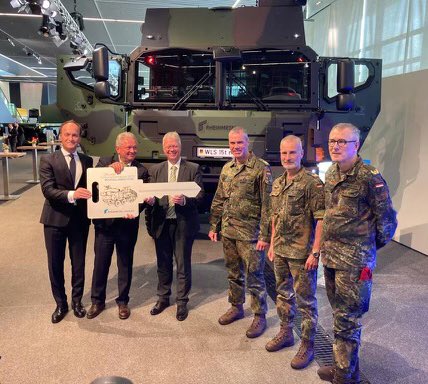
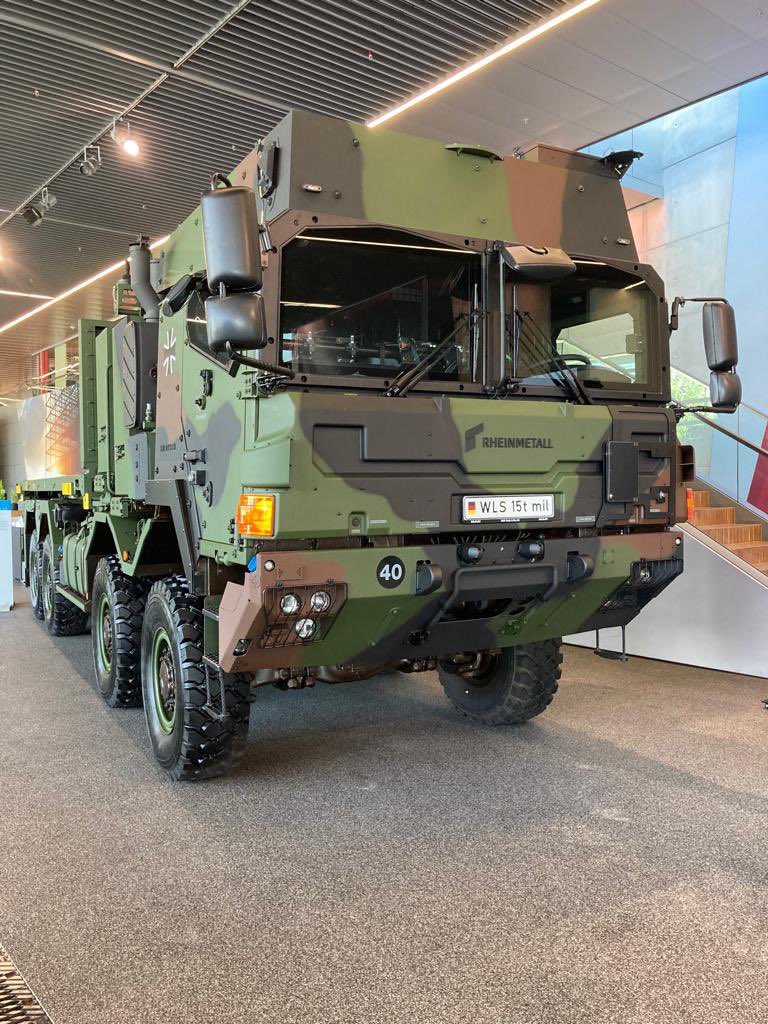
("neue Generation der Wechselladersysteme")
Hivatalos átadási ceremónia az új generációs raklapos rakománykezelő rendszer és a 3000. páncélozás nélküli (UTV/UTF) szállítójármű szállításához
2020 júniusában a Bundeswehr keretszerződést kötött a Rheinmetall MAN Military Vehicle Systems-szel (RMMV) akár 4000 raklapos rakománykezelő rendszer szállítására. A keretmegállapodás 2027-ig szól. A németül Wechselladersysteme vagy WLS néven ismert raklapos rakománykezelő rendszerek az RMMV HX katonai teherautó-családjára vannak felszerelve, amelyek magas szintű rendszerazonosságot biztosítanak a már kihelyezett UTV/UTF-ekkel.
A WLS legfőbb jellemzője a Hiab cég által kifejlesztett horgos rakodó. A Bundeswehr WLS teherautóinak nagy része védett kabinnal rendelkezik.
UTV/UTF : Unprotected Transport Vehicles / Ungeschützte Transport Fahrzeuge
Május elejéig 3000 UTF járművet adtak át a megrendelőnek – közel ezerrel többet, mint az az eredeti keretmegállapodás szerint 2024-ig tervezett volt. Az RMMV tehát jóval az ütem előtt jár ebben a projektben.”
Armin Papperger is hangsúlyozta beszédében a WLS és az UTF kiemelt fontosságát a vállalat számára. A WLS és UTF projektek hozzáadott értékének nagy része – több mint 75 százaléka – Németországban keletkezik. A Bundeswehrrel szorosan együttműködve az RMMV évi 1000 járműre növelte UTF kapacitását.
A WLS és az UTF is az RMMV robusztus HX járműcsaládján alapul. Kezdettől fogva katonai használatra tervezték, és még kemény terepen is kiemelkedő mobilitást mutatnak. A HX járműcsalád széles körű elterjedése világszerte jelentős előnyökkel jár az interoperabilitás és a logisztika terén. A felhasználói nemzetek körébe más országok mellett most már tartozik az Egyesült Királyság, Ausztrália, Új-Zéland, Norvégia, Svédország, Ausztria, Magyarország és Dánia.
W
Wilson
Guest
A német kormánykoalíció megállapodott az ellenzéki konzervatív CDU/CSU tömbbel egy speciális Bundeswehr-alap létrehozásának főbb részleteiről a német hadsereg finanszírozásának 100 milliárd euróval történő növelésére.
Az European Truth szerint ez áll a DW kiadványban .
A különleges alap jóváhagyása nagyszabású fegyverrendeléssel jár.
"A beszerzések felgyorsítására irányuló kezdeményezést közvetlenül a nyári parlamenti szünet előtt terjesztik elő" - áll a kormány és az ellenzék tisztségviselőinek közös közleményében május 29-én, vasárnap este, több mint háromórás tárgyalás után.
A speciális alap létrehozásához
alkotmánymódosításra van szükség, hiszen az alaphoz hitelt vonnak majd be, és Németország alaptörvénye tulajdonképpen tiltja az új strukturális hitelfelvételt.
Az alaptörvény módosításához kétharmados többségre van szükség a Bundestagban és a Bundesratban, amit a kormánykoalíció önerőből az ellenzék részvétele nélkül nem tudna megszerezni.
Christian Lindner pénzügyminiszter szerint azt tervezik, hogy meghatározzák e kiadások "speciális jellegét" a Bundeswehr számára.
Olaf Scholz kancellár február 27-én, miután Oroszország megtámadta Ukrajnát, bejelentette egy 100 milliárd eurós Bundeswehr speciális alap létrehozását és a NATO úgynevezett 2%-os céljának betartását, amelyet átlagosan néhány éven belül el kell érni
Az European Truth szerint ez áll a DW kiadványban .
A különleges alap jóváhagyása nagyszabású fegyverrendeléssel jár.
"A beszerzések felgyorsítására irányuló kezdeményezést közvetlenül a nyári parlamenti szünet előtt terjesztik elő" - áll a kormány és az ellenzék tisztségviselőinek közös közleményében május 29-én, vasárnap este, több mint háromórás tárgyalás után.
A speciális alap létrehozásához
alkotmánymódosításra van szükség, hiszen az alaphoz hitelt vonnak majd be, és Németország alaptörvénye tulajdonképpen tiltja az új strukturális hitelfelvételt.
Az alaptörvény módosításához kétharmados többségre van szükség a Bundestagban és a Bundesratban, amit a kormánykoalíció önerőből az ellenzék részvétele nélkül nem tudna megszerezni.
Christian Lindner pénzügyminiszter szerint azt tervezik, hogy meghatározzák e kiadások "speciális jellegét" a Bundeswehr számára.
Olaf Scholz kancellár február 27-én, miután Oroszország megtámadta Ukrajnát, bejelentette egy 100 milliárd eurós Bundeswehr speciális alap létrehozását és a NATO úgynevezett 2%-os céljának betartását, amelyet átlagosan néhány éven belül el kell érni
A német kancellár arról is beszélt, hogy a Bundeswehr évtizedeken át alulfinanszírozott volt, ezért bővíteniük kell az eszközállományukat, illetve kitért is, hogy emiatt lassabban tudják leszállítani a szövetséges országoknak ígért harcjárműveket.

 www.portfolio.hu
www.portfolio.hu

Bejelentette Scholz: Európa legnagyobb hadseregét építi fel Németország
Európa legnagyobb, NATO-n belüli, konvencionális haderejét hozza létre Németország – mondta Olaf Scholz német kancellár a német sajtónak.
Ebből egy kukkot sem értek. Ez mekkora erő is?
Olyan hadosztály méret (kicsit alatta)Ebből egy kukkot sem értek. Ez mekkora erő is?
W
Wilson
Guest
Görögország páncélozott járműveket ad Ukrajnának és Németországtól kapja a pótlást - Olaf Scholz
Olaf Scholz német kancellár kedden kijelentette, hogy Németország gyalogsági harcjárműveket adna a görög hadseregnek, azért,hogy cserébe Görögország átadja Ukrajnának a szovjet korszakból származó páncélozott járműveit.
"Gyalogsági harcjárműveket fogunk biztosítani Görögországnak" - idézte Scholzot a Reuters kedden, az EU-csúcstalálkozót követően.
Scholz nem beszélt a részletekről.
A katonai kézikönyvek szerint Görögországnak van jó néhány BMP-1-es, amelyet egykor ugyanattól a Németországtól kapott: az NDK hadseregében álltak szolgálatban.

 t.me
t.me
Olaf Scholz német kancellár kedden kijelentette, hogy Németország gyalogsági harcjárműveket adna a görög hadseregnek, azért,hogy cserébe Görögország átadja Ukrajnának a szovjet korszakból származó páncélozott járműveit.
"Gyalogsági harcjárműveket fogunk biztosítani Görögországnak" - idézte Scholzot a Reuters kedden, az EU-csúcstalálkozót követően.
Scholz nem beszélt a részletekről.
A katonai kézikönyvek szerint Görögországnak van jó néhány BMP-1-es, amelyet egykor ugyanattól a Németországtól kapott: az NDK hadseregében álltak szolgálatban.

BBC News | Русская служба
Греция даст Украине бронемашины и получит от Германии замену – Олаф Шольц Канцлер Германии Олаф Шольц сказал во вторник, что Германия даст греческой армии боевые машины пехоты, чтобы Греция отдала свои бронемашины советского образца Украине. "Мы обеспечим Грецию боевыми машинами пехоты", –...
Kapnak helyette lynx-tGörögország páncélozott járműveket ad Ukrajnának és Németországtól kapja a pótlást - Olaf Scholz
Olaf Scholz német kancellár kedden kijelentette, hogy Németország gyalogsági harcjárműveket adna a görög hadseregnek, azért,hogy cserébe Görögország átadja Ukrajnának a szovjet korszakból származó páncélozott járműveit.
"Gyalogsági harcjárműveket fogunk biztosítani Görögországnak" - idézte Scholzot a Reuters kedden, az EU-csúcstalálkozót követően.
Scholz nem beszélt a részletekről.
A katonai kézikönyvek szerint Görögországnak van jó néhány BMP-1-es, amelyet egykor ugyanattól a Németországtól kapott: az NDK hadseregében álltak szolgálatban.

BBC News | Русская служба
Греция даст Украине бронемашины и получит от Германии замену – Олаф Шольц Канцлер Германии Олаф Шольц сказал во вторник, что Германия даст греческой армии боевые машины пехоты, чтобы Греция отдала свои бронемашины советского образца Украине. "Мы обеспечим Грецию боевыми машинами пехоты", –...t.me

W
Wilson
Guest
Kétlem persze ha meghitelezik nekik a krautok akkor elképzelhető....Kapnak helyette lynx-t

S
speziale
Guest
közben rendszerbe állt a DM73:
https://ted.europa.eu/udl?uri=TED:NOTICE:196970-2022:TEXT:EN:HTML&src=0
https://ted.europa.eu/udl?uri=TED:NOTICE:196970-2022:TEXT:EN:HTML&src=0
W
Wilson
Guest
Kapnak helyette lynx-t
Görögország megerősítette annak lehetőségét, hogy BMP-1-t átadja Ukrajnának...
A görög kormány megerősítette a BMP-1 páncélozott csapatszállítók átadását Ukrajnának. Helyettük modern német Mardereket kapnak.
Az ezzel kapcsolatos információk a görög kormány honlapján érhetők el.
A páncélozott járművek pontos számát nem adják meg, de megjegyzik, hogy a Görögországnak atadott felszerelés mennyiségének meg kell egyeznie azzal, amennyit Ukrajnának adnak.
A további tárgyalások folytatódnak.
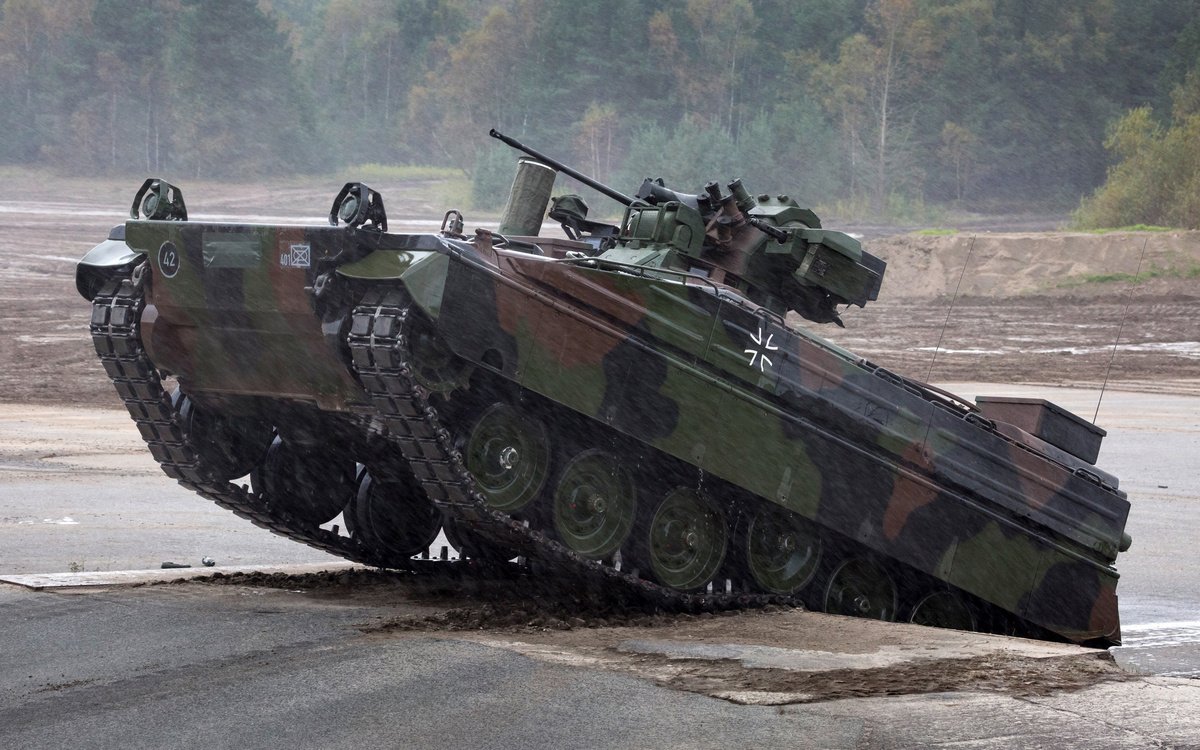
Marder
Egy nappal korábban vált ismertté , hogy lehetséges ilyen felszerelés csere .
Emlékeztetni kell arra, hogy Görögország fel van szerelve BMP-1-l, amelyet korábban a Német Demokratikus Köztársaság (NDK) hadserege használt, és a Bundeswehrnek nem volt szüksége rájuk a német egyesülés után.
Minden görög BMP csehszlovák gyártású volt, és átesett a helyi módosításon, aminek eredményeként megkapta a BMP-1A1 Ost indexet.

Az 1990-es években Görögország mintegy 500 ilyen páncélozott szállítójárművet kapott, amelyek egy részét Egyiptomba, egy részét Irakba, 100 BMP-1-t pedig Irakba szállították, ahol aktívan részt vettek az Iszlám Állam fegyveresei elleni harcban.
Pedig a letárolt német MARS2-kre én fentem a fogam...

 www.defenseromania.ro
www.defenseromania.ro

Mass-media germană: Berlinul ar vrea să ofere Ucrainei mai multe lansatoare de rachete MARS II
Germania ar vrea să furnizeze Ucrainei patru sisteme de rachete cu lansatoare multiplă MARS II, precizează cotidianul german Tagesspiegel, citând surse guvernamentale de la Berlin.
T
Törölt tag
Guest
4dbPedig a letárolt német MARS2-kre én fentem a fogam...

Mass-media germană: Berlinul ar vrea să ofere Ucrainei mai multe lansatoare de rachete MARS II
Germania ar vrea să furnizeze Ucrainei patru sisteme de rachete cu lansatoare multiplă MARS II, precizează cotidianul german Tagesspiegel, citând surse guvernamentale de la Berlin.www.defenseromania.ro



